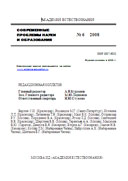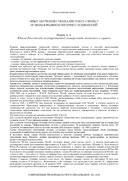PDF-версия статьи


|
The use of information and communication technologies in the field of health care can contribute significantly to relieving tension and solving the problem of accessibility and improving the quality of medical services. The introduction of high-quality medical services for sparsely populated sites, remote from large cities, where the organization of medical institutions with full staffing is unprofitable, also testifies to their introduction.[1]
ICT in health care solves the following tasks:
1) prevention and early diagnosis of diseases, timely provision of median care to patients;
2) effective use of available resources in health care, including equipment designed to provide high-tech medical care, expensive medicines, donor materials and preparations based on them;
3) reference and information support for making medical decisions, including by providing prompt access to complete and reliable information about the patient´s health as a result of the introduction of electronic health cards, the introduction of automated procedures for verifying the compliance of the selected treatment with the standards of medical care, verifying the compliance of the prescribed drugs with existing contraindications;
4) obtaining medical consultations by persons who are not able to visit medical organizations;
5) quality education, continuous training, conducting effective scientific research, as well as active professional interaction of medical and pharmaceutical specialists;
6) increasing the level of medical literacy of citizens;
7) improving the accuracy of patient compliance with the received appointments through the use of information and telecommunication technologies;
8) ensuring the collection, storage and access to databases with medical and management information for health workers and the provision of public services in this area.
Foreign experience shows that the socio-economic effect of the introduction and use of ICT in the health sector is very significant. For example, to improve customer service; in order to increase the number of patients served, without reducing the quality of services provided; to reduce the number of medical staff to reduce costs.
The use of ICT in the health care system presupposes the availability of specialists with the necessary qualifications who are able to work with equipment and support the work of the information system itself. At the same time, one of the main reasons for the lack of ICT implementation identified in the Concept of development of the information technology industry of the Republic of Kazakhstan was the lack of awareness and computer literacy of the population. In this situation, there is a certain difficulty in creating a working group of doctors and programmers.[2] Creating a unified health information system requires a stable communication, high-speed Internet. The fact is that information of a medical nature often requires very fast transmission with large volumes of information (for example, when it comes to remote counseling during emergency operations). However, unfortunately, the laying of fiber optic cables is currently not possible in all settlements of the Republic of Kazakhstan, which creates certain risks in the implementation of programs for the informatization of medicine. The lack of normal transport communications also dramatically reduces the efficiency of mobile telemedicine systems.
At the end of this article, we focus on the fact that the implementation of informatiz
ОПУБЛИКОВАНО
G.T.Koshtaeva., S.S.Mombekova., M.M.Turganbekova.,K.U.Nyshanbayeva., A.T.Saparova INFORMATION AND COMMUNICATION TECHNOLOGIES IN HEALTH SERVICES. // Современные проблемы науки и образования - 2019.-№6. (приложение "Технические науки"). - C. 4